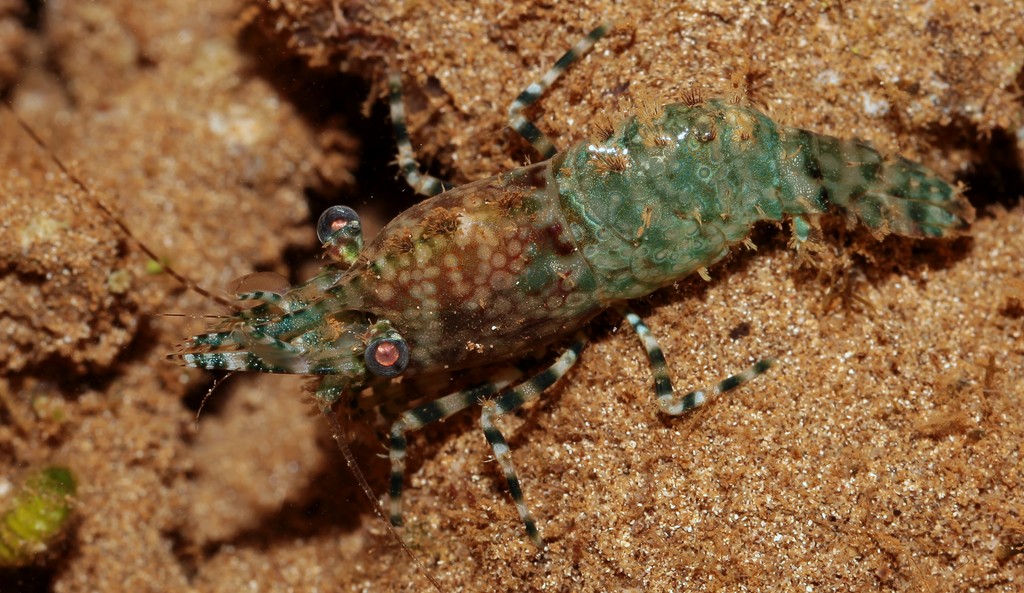SARON MARMORATUS - (OLIVIER, 1811)
Arthropoda (Phylum) > Crustacea (Subphylum) > Malacostraca (Class) > Eumalacostraca (Subclass) > Eucarida (Superorder) > Decapoda (Order) > Pleocyemata (Suborder) > Caridea (Infraorder) > Alpheoidea (Superfamily) > Hippolytidae (Family) > Saron (Genus)
Crevette marbrée, crevette saron, crevette en marbre, Crevette singe, tapestry marble shrimp, common Marble Shrimp, marbled shrimp, marble Shrimp, saron shrimp, Camarão mármore, Marmo Gamberetti, Camarón de mármol,
Description
Carapace blanche avec taches rouges, grandes pattes annelées blanc et rouge foncé. Les femelles ont des appendices touffus à l'extrémité du rostre, au milieu du dos, sur le bord externe de la carapace dorsale et sur une paire de pattes antérieures. Strictement carnivore. Taille adulte max. 6cm. Profondeur 0 - 30m.
Biotope
Cette crevette vit le long des récifs coralliens, souvent proche des cavités et des grottes où l'on peut l'observer de nuit. Elle est aussi présente sur les récifs frangeants.
Distribution
Indo-Pacifique. Présent en Nouvelle-Calédonie.
Espèce ressemblante
Saron neglectus (de Man, 1902) qui est plus petite et moins poillu que saron marmoratus. Les pattes sont striées par de nombreux cercles.
Synonymes
Hippolyte gibberosus (H. Milne Edwards, 1837 [in H. Milne Edwards, 1834-1840])
Hippolyte hemprichii (Heller, 1861)
Hippolyte leachii (Guérin-Méneville, 1838 [in Guérin-Méneville, 1829-1838])
Hyppolite kraussii (Bianconi, 1869)
Nauticaris grandirostris (Pearson, 1905)
Palaemon marmoratus (Olivier, 1811)
----------------------------------------------------------
Description
During the day it is brown with green spots. These green spots will have variable amounts of white speckling. The legs have darker brown bands on a brown background with alternating white speckled bands. Tufts of cirri (feathery appendages) are found decorating the back of the males, and their first pair of walking legs are elongated. The Saron Shrimp is nocturnal, and at night, the color of its body turns primarily red, which helps it blend into the shadows of the twilight.
Similar species
Saron neglectus (de Man, 1902), which is smaller and less hairy. Distinguishable by coloration of the legs.
Distribution
Entire Indo-Pacific Ocean: Hawaii to the Red Sea. Reported in New Caledonia.
Biotop
It found in the coral rubble at the bottom of the reef, bay areas and lagoons.
Crevette marbrée, crevette saron, crevette en marbre, Crevette singe, tapestry marble shrimp, common Marble Shrimp, marbled shrimp, marble Shrimp, saron shrimp, Camarão mármore, Marmo Gamberetti, Camarón de mármol,
Description
Carapace blanche avec taches rouges, grandes pattes annelées blanc et rouge foncé. Les femelles ont des appendices touffus à l'extrémité du rostre, au milieu du dos, sur le bord externe de la carapace dorsale et sur une paire de pattes antérieures. Strictement carnivore. Taille adulte max. 6cm. Profondeur 0 - 30m.
Biotope
Cette crevette vit le long des récifs coralliens, souvent proche des cavités et des grottes où l'on peut l'observer de nuit. Elle est aussi présente sur les récifs frangeants.
Distribution
Indo-Pacifique. Présent en Nouvelle-Calédonie.
Espèce ressemblante
Saron neglectus (de Man, 1902) qui est plus petite et moins poillu que saron marmoratus. Les pattes sont striées par de nombreux cercles.
Synonymes
Hippolyte gibberosus (H. Milne Edwards, 1837 [in H. Milne Edwards, 1834-1840])
Hippolyte hemprichii (Heller, 1861)
Hippolyte leachii (Guérin-Méneville, 1838 [in Guérin-Méneville, 1829-1838])
Hyppolite kraussii (Bianconi, 1869)
Nauticaris grandirostris (Pearson, 1905)
Palaemon marmoratus (Olivier, 1811)
----------------------------------------------------------
Description
During the day it is brown with green spots. These green spots will have variable amounts of white speckling. The legs have darker brown bands on a brown background with alternating white speckled bands. Tufts of cirri (feathery appendages) are found decorating the back of the males, and their first pair of walking legs are elongated. The Saron Shrimp is nocturnal, and at night, the color of its body turns primarily red, which helps it blend into the shadows of the twilight.
Similar species
Saron neglectus (de Man, 1902), which is smaller and less hairy. Distinguishable by coloration of the legs.
Distribution
Entire Indo-Pacific Ocean: Hawaii to the Red Sea. Reported in New Caledonia.
Biotop
It found in the coral rubble at the bottom of the reef, bay areas and lagoons.
